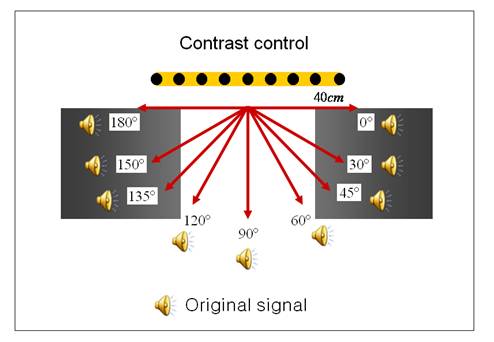
Figure 1.
Lay Language Paper Index | Press Room ]
Chan-Hui Lee, chance99@kaist.ac.kr
Chan-Hui Lee, Ji-Ho Chang, Jin-Young Park, and Yang-Hann Kim
Center for Noise and Vibration Control (NOVIC)
Korea Advanced Institute of Science and Technology (KAIST)
Popular Version of Paper 4aEA4, “Personal sound system design for mobile phone, monitor, and television set; Feasibility study”
Presented 9:45 a.m. Friday morning, November 30, 2007
154th ASA Meeting,New Orleans, LA
Can you imagine listening to music at a comfortable volume on loudspeakers while people standing right next to you cannot even hear it? Whether you are using an MP3 player, a personal media player (PMP), a smart phone or a loudspeaker-embedded monitor, you may soon be able to enjoy audio without those uncomfortable earphones or headsets and not bother your neighbors. To realize this situation physically, the energy of sound waves must be focused on a specific region called the ‘Listening Zone’. We name the system that can create this kind of listening zone a ‘Sound Focused Personal Audio System.’
The principle of sound focusing is to use interference of sound waves. By employing the interference of sound waves from several loudspeakers, we want to use constructive interference to create a ‘Listening Zone’ and a use destructive interference to create an ‘Un-listening Zone.’
Sound focusing techniques using sound-source arrays in acoustics have been studied actively for therapeutic ultrasound and ocean acoustics from the early 1990s. Phase conjugation methods (by Jackson and Dowling in 1990), time reversal acoustics (by Fink in 1992), and inverse filtering (by Fink in 2000) are examples of focusing techniques for achieving a point focus. However, to achieve a sound focused personal audio system, we need to consider a larger region of focus because a human head is not just a point. The regional sound focusing method was first suggested in our research group by Choi and Kim in 2002 [J. Acoust. Soc. Am. 111(4) 1695-1700(2002)]. It is called as ‘Acoustic contrast control’ and effectively maximizes the acoustic energy ratio between ‘Listening Zone’ and ‘Un-listening Zone’. Using acoustic contrast control, we can obtain the required input signals (magnitude and phase) that are supposed to be in each loudspeaker. Nowadays, we are trying to see the feasibility of this regional focusing method for applying a personal audio system design.
Actually, designing a sound focused personal audio system is not an easy problem because there are several control parameters, such as number of loudspeakers, loudspeaker array aperture, definitions of ‘Listening zone’ and ‘Un-listening Zone’ etc. Furthermore these control parameters are not mutually independent. To start from the simple case, we defined a sound system with 9-loudspeaker-embedded 17’’ model monitor and defined the ‘Listening Zone’ and ‘Un-listening Zone’ as shown below. In this experiment, we defined the interesting frequency region as from 800Hz to 5kHz.

Figure 1.

Figure 2.

Figure 3.
As a result, using acoustic contrast control, we could make the sound field which has over 20dB SPL sound pressure level difference between ‘Listening zone’ and ‘Un-listening Zone’ for interesting frequency band. To compare the results, we also measured sound field when the input signals are all equal.
Movie clip : comparison.wmv (download)
To see the feasibility for sound focused personal audio system, we applied this technique for music sound. As you have seen a previous movie clips, you can hear the result from actual recorded signal at certain points below.
Original sound file (download)
 |
 |
From the feasibility study, we could observe the possibility to apply to sound focused personal audio system. However, there are still several things to study because we do not have any reasonable performance index to evaluate focused personal audio system and also studies for other sound focused personal audio system models still remains. The truth is our research can help to open the new era of personal audio system. If you dream, the future is not far from now.